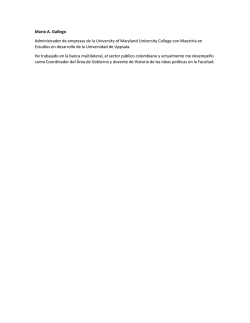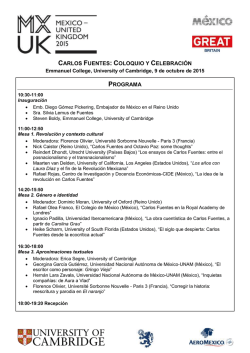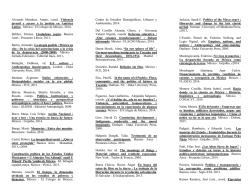
Pulse aquí para obtener el archivo
LA GRAN DIVERGENCIA DE LA NO –EUROPA ANTES DE 1800: Bibliografía La gran divergencia de la noEuropa antes de 1800. BIBLIOGRAFÍA Rafael Barquín Gil Departamento de Economía Aplicada e Historia Económica Universidad Nacional de Educación a Distancia (UNED) Contenido REFERENCIAS BIBLIOGRÁFICAS ................................................................................ 2 INTRODUCCIÓN ........................................................................................................... 2 TEMA 1: POBLACIÓN Y RECURSOS ........................................................................ 2 TEMA 2: CONQUISTA Y COLONIZACIÓN (SIGLOS X-XVIII) .............................. 3 TEMA 3: EL ISLAM Y LA INDIA ................................................................................ 3 TEMA 4 CHINA Y JAPÓN ............................................................................................ 5 1 RAFAEL BARQUÍN GIL (Economía Aplicada e Historia Económica. UNED) | UNED 2014 LA GRAN DIVERGENCIA DE LA NO –EUROPA ANTES DE 1800: Bibliografía REFERENCIAS BIBLIOGRÁFICAS INTRODUCCIÓN Acemoglu, Daron, 2013: Por qué fracasan los países. Deusto. Elvin, Mark, 2006: The retreat of the elephants: an environmental history of China. Yale University Ferguson, Niall, 2012: Civilización: occidente y el resto. Debate. Frank, Andre Gunder, 1998: Reorient: global economy in the Asian age. University of California Press Jones, Eric L, 1990: El milagro europeo. Alianza Landes, David, S., 2008: La riqueza y la pobreza de las naciones. Crítica Marks, Robert, 2007: Los orígenes del mundo moderno. Crítica. Needham, Joseph, 1977: La gran titulación: ciencia y sociedad en Oriente y Occidente. Alianza Pomeranz, Keneth, 2000: The great divergence : China, Europe, and the making world economy. Princenton University. Williamson, Jeffrey G., 2013: El desarrollo económico mundial en perspectiva histórica. Prensas Universitarias de Zaragoza TEMA 1: POBLACIÓN Y RECURSOS Jones, Eric Lionel, 1994: El milagro europeo, Alianza Livi-Bacci, Massimo, 1990: Historia mínima de la población mundial, Crítica. Malthus, Robert, 1803: An Essay on the Principle of Population O’Grada, Cormac, 2009: Famine, a short history. Princeton University Press. Rotberg, Robert I. y Rabb, Theodore K., (comp), 1990: El hambre en la Historia, Siglo XXI Sen, Amartya, 1982: Poverty and famines. Oxford University Press. Thornton, Russell, 1987: American Indian Holocaust and Survival: A Population History Since 1492. University of Oklahoma Press. 2 RAFAEL BARQUÍN GIL (Economía Aplicada e Historia Económica. UNED) | UNED 2014 LA GRAN DIVERGENCIA DE LA NO –EUROPA ANTES DE 1800: Bibliografía TEMA 2: CONQUISTA Y COLONIZACIÓN (SIGLOS X-XVIII) Bennassar, Bartolomé, 1987: La América española y la América portuguesa Siglo XVI-XVIII. Akal. Chaunu, Pierre, 1977: La expansión europea (siglos XIII al XV). Labor Chaunu, Pierre, 1984: Conquista y explotación de los nuevos mundos. Labor Chauduri, Kirti, 1985: Trade and Civilisation in the Indian Ocean, Cambridge University Press. Crosby, Alfred W., 1988: Imperialismo ecológico, Crítica Davis, Ralph, 1976: La Europa atlántica, Crítica. Denevan, William, 1992: The Native Population of the Americas in 1492. University of Wisconsin. Fieldhouse, David K., 1987: Los imperios coloniales desde el siglo XVIII. Siglo XXI. Frank, Ander Gunder, 1979: La acumulación mundial, 1492-1789, Siglo XXI Jones, Eric Lionel, 1994: El milagro europeo, Alianza Landes, Daniel S. 1999: La riqueza y la pobreza de las naciones. Crítica Mauro, Frédéric, 1979: La expansión europea (1600-1870), Labor. Thornton Rusell, 1987: American Indian Holocaust and Survival: A Population History Since 1492. University of Oklahoma Press Wallerstein, Immanuel, 1984: El moderno sistema mundial II, El mercantilismo y la consolidación de la economía-mundo europea 1600-1750. Siglo XXI Yun, Bartolomé, 2004: Marte contra Minerva, Crítica. TEMA 3: EL ISLAM Y LA INDIA Baechler, Jean, 1988: “The origins of modernity: caste and feudality (India, Europe and Japan)” en Baechler Jean, John A. Hall and Michael Mann (eds) Europe and the rise of capitalism. Basil Blackwell: 39-65 Broadberry, Stephen and Bishnupriya Gupta, 2005: “Cotton textiles and the great divergence: India and shifting competitive advantage, 1600-1850” The Economic History Review, 59, 1: 2-31 3 RAFAEL BARQUÍN GIL (Economía Aplicada e Historia Económica. UNED) | UNED 2014 LA GRAN DIVERGENCIA DE LA NO –EUROPA ANTES DE 1800: Bibliografía Çizarça, Murat, 1995: “Cash Waqfs of Bursa, 1555-1823” Journal of the Economic and Social History of the Orient, 38, 3: 313-54. Embree, Ainslie T. y Friedrich Wilhelm, 1974 (2002): India. Siglo XXI. Goldschmidt Jr., Arthur, 2002: A Concise History of the Middle East. Wetsview Press. Gómez García, Luz, 2009: Diccionario del Islam y el islamismo. Espasa. Grunebaum, Gustave Edmund von, 1981: El Islam. Desde la caída deConstantinopla hasta nuestros días. Siglo XXI. Holt, P.M., Ann K.S. Lambton and Bernard Lewis (eds), 1970: The Cambridge History of Islam. Cambridge University Press. Hoodbhoy, Pervez, 2000: El islam y la ciencia. Bellaterra. Imber, Colin, 2004: El imperio otomano 1300-1650. Vergara Jones, Eric L., 1987, El milagro europeo. Alianza, Madrid. Kulke, Hermann and Dietmar Rothermund, 1986: A History of India. Routledge. Kuran, Timur, 2011: The long divergence. Princenton University Press. Maddison, Angus, 1971: Class Structure and Economic Growth. India andPakistan since the Moghuls Routledge. Matthee, Rudolph P., 1999: The Politics of Trade in Safavid Iran: Silk for Silver,1600-1730. Cambridge University Press. Prakash, Om, 1998: European Commercial Enterprise in Pre colonial India. TheNew Cambridge History of India, Cambridge University Press. Richards, John, 1993: The Mughal Empire. Cambridge University Press Sellier, Jean y André, 1997: Atlas de los pueblos de Oriente. Acento. Savory, Roger M., 1980: Iran Under the Safavids. Cambridge University Press Shaw, Standford J., 1976: History of the Ottoman Empire and Modern Turkey. Cambridge University Press. Streusand, Douglas E., 2011: Islamic gunpowder empires. Westview Press Studer, Roman, 2008: “India and the great divergence: assessing the efficiency of grain markets in 18th and 19th century India.” Journal of Economic History, 68, 2: 393-437. Vercellin, Giorgio, 2003: Instituciones del mundo musulmán. Bellaterra. 4 RAFAEL BARQUÍN GIL (Economía Aplicada e Historia Económica. UNED) | UNED 2014 LA GRAN DIVERGENCIA DE LA NO –EUROPA ANTES DE 1800: Bibliografía TEMA 4 CHINA Y JAPÓN Cullen, L.M., 2003: A History of Japan, 1582-1941. Cambridge University Press. Deng, Gang, 2007: The premodern Chinese economy. Routledge. Hall, John Whitney, 1973: El imperio japonés. Siglo XXI. Franke Herbert y Rolf Trauzettel, 1973: El imperio chino. Siglo XXI. Frank, Andre Gunter, 1998: ReOrient: global economy in the Asian Age. University of California. Jones, E.L., 1988: Crecimiento recurrente. Alianza. Kondo Hara, Agustín Y., 1999: Japón: evolución histórica de un pueblo (hasta 1650). Nerea. Landes, David S., 2000: La riqueza y la pobreza de las naciones. Crítica. Mokyr, Joel, 1993: La palanca de la riqueza: creatividad tecnológica y progreso económico, Madrid, Alianza Needham, Joseph, 2000: Science and civilisation in China. Cambridge University Press. 5 RAFAEL BARQUÍN GIL (Economía Aplicada e Historia Económica. UNED) | UNED 2014
© Copyright 2025


